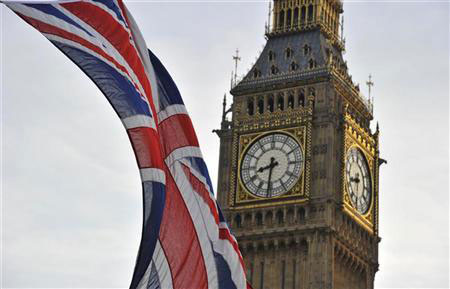有报告显示,伦敦著名的大本钟加速倾斜,甚至有倒塌的可能性。根据该报告,大本钟向左倾斜约46厘米,已经达到肉眼可以观察的程度。不过,有专家乐观地表示,以大本钟目前的倾斜速度,要再过1万年才会有危险。大本钟坐落于英国议会大厦东侧高96米的钟楼上,是伦敦的传统地标。

|
 A Union flag flies near Big Ben and the Houses of Parliament in London October 24, 2011. |
The landmark clock tower containing Big Ben at Britain's Palace of Westminster, is tilting, while media reports Monday said the mother of all parliaments was slipping into the River Thames, raising fears over its future.
The House of Commons commission, which is responsible for the upkeep of the 19th century neo-Gothic parliamentary estate popular with tourist photographs, was due to meet Monday.
Media reports said it would discuss a surveyor's report which could recommend lawmakers move out for repairs costing up to one billion pounds, while the Daily Telegraph said another proposal might be to sell to Russian or Chinese developers for about 500 million pounds ($779.7 million).
But a commission spokesman said there was no surveyor's report, and members were only meeting to discuss setting up a group to look at general long-term renovation of the grade 1-listed building designed by Charles Barry and Augustus Welby Pugin.
"I think there's been twos and twos added together and come up with we are selling to the Russians, but they won't be talking about anything like that," the spokesman said.
The 96-metre tall clock tower, which houses the bell originally nicknamed Big Ben, leans about 46 cm to the left of its peak.
A construction expert who worked on the leaning tower of Pisa in Italy and a multi-storey carpark under the houses of parliament in central London, said there was nothing to worry about, and it would take 10,000 years to reach an angle of concern.
Professor John Burland of Imperial College London also said work on the underground Jubilee train line in the 1990s had not caused dramatic movement, while a spokesman for the commission said the tilt could have existed since its construction in 1859.
The lean which is just visible to the naked eye had "been there for years," Burland said.
"When I first started work on the car park it was obvious that it was leaning," he told BBC radio.
"It was probably developed at a very early stage because there's no cracking in the cladding and we think it probably leant while they were building it and before they put the cladding on.
"That was a long time ago and buildings do lean a little bit."
He also dismissed concern in the media that parliament was slipping into the Thames, while the commission's spokesman denied the walls around the palace were suffering from a particularly bad subsidence problem causing Big Ben to lean.
The current building, which houses the upper and lower chambers as well as the offices of some lawmakers, was built after its medieval predecessor was largely destroyed by fire in 1834 and has required constant maintenance.
"There's no such thing as an old building that isn't cracked," he said.
"In fact they're beneficial because the building moves thermally more than is caused by the Jubilee Line and the movements concentrated around the cracks and, if they didn't, there'd be cracking elsewhere.
"So these have been there for years and they're certainly not caused by the Jubilee Line or the car park."
相关阅读
(Agencies)

(英语点津 陈丹妮 编辑)
